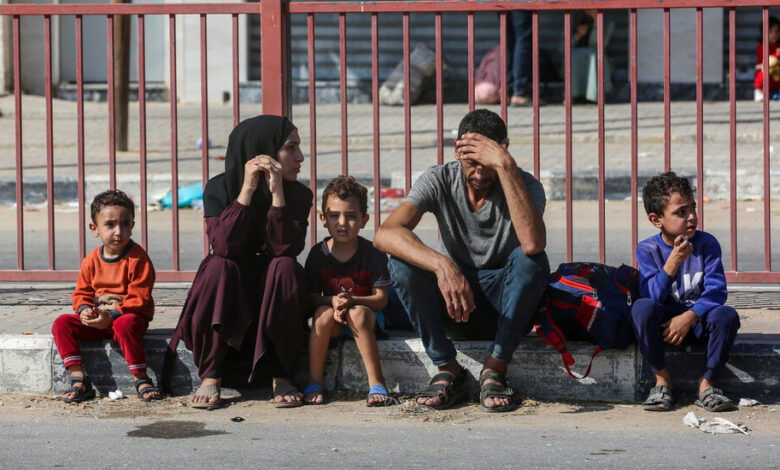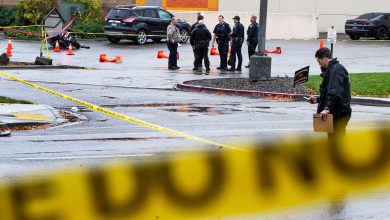Israel’s Ticking Clock – The New York Times

The invasion seemed imminent. In the hours after Hamas attacked Israel on Oct. 7, Benjamin Netanyahu appeared ready to send his troops storming into Gaza. Instead, he chose a different strategy.
Israel’s initial ground invasion was slow and secretive, more of a crawl than a sprint. Gaza is tiny, about the size of Las Vegas. But Israel took days to cross the border, surround Gaza City and move in — a strategy that the country’s defense minister called “tightening the noose.” Even that fight has been halting, and White House officials said yesterday that Israel had agreed to allow daily four-hour pauses so civilians could evacuate. (Read what we know about the battle for Gaza City so far.)
Israel has slowed down to develop a plan that could accomplish two difficult — and competing — goals.
First, it wants to eliminate Hamas. The Israeli government sees the group as an intolerable threat on its border after the Oct. 7 attack, which officials say killed roughly 1,400 people. Hamas is committed to Israel’s destruction; one of its leaders recently promised to keep attacking until Israel was destroyed.
Second, Israel’s leaders need to protect their international standing and maintain their allies’ support. Israel’s attacks, which have killed thousands of civilians, have already hurt its reputation and its relationships. Many countries have recalled their ambassadors or condemned Israel at the United Nations. They say Israel has gone too far — and the war has only just started.
“Israel set itself some pretty tight objectives,” Lawrence Freedman, an expert on military strategy, told me. “It did not say degrade or reduce Hamas. It said eliminate or crush. That’s actually quite hard to do.”
This tension — between Israel’s vow to crush Hamas and also find a long-term solution to a notoriously intractable conflict — explains why the military has slowed down. It has taken time to consult with allies, determine its strategy and try to weaken Hamas. But now, U.S. officials are getting impatient. They want Israel to complete its mission before the anger over the war destabilizes the Middle East, meaning the country’s slow approach may have reached its limit.
Below, we explain Israel’s strategy in more detail.
Tactical benefits
The encirclement of Gaza City highlights Israel’s slow approach.
Over the course of two weeks, Israeli tanks and troops entered Gaza from three directions, surrounding Gaza City. Israel has described Gaza City as a major hub for Hamas’s military. But instead of immediately entering the city’s dense maze of streets on foot to seal off tunnels, find weapons stores and kill fighters, Israel waited on the outskirts.
During this time, Israel took precautions to protect its troops. The military moved hundreds of armored vehicles and thousands of troops into northern Gaza, essentially creating a giant military camp, which my colleague Ronen Bergman visited, on Gaza’s coast. It also combed Gaza’s northern land for mines, tunnels and militants as it took control of territory. In doing so, Israel signaled that it was preparing for a long, difficult war.
Israel also used this time to weaken Hamas before troops entered Gaza City. It continued to strike Gaza, destroying many of the buildings Hamas could use as bunkers and sniper locations. (See maps of the strikes.)
“It’s what we call a shaping operation,” Alex Plitsas at the Atlantic Council explained. “They’re going to hit as much of the infrastructure, weapons and military targets as they can from the air so they reduce the risk to the troops on the ground.”
By waiting to invade, Israel also gave its blockade of resources time to take effect, allowing food, fuel and water to dwindle for both fighters and civilians. Food and clean water are now nearly nonexistent in Gaza City, forcing people to ransack bakeries for the last of the flour. Experts say the blockade will force Hamas to draw down on the supplies it has stockpiled underground for years.
Political constraints
Israeli officials said their slow approach was intended to help their military, my colleague Mark Landler reported. But the delay has also served another purpose: It has given Israel time to consult with its allies, many of whom are facing extraordinary pressure from their citizens to de-escalate the conflict.
Israel’s attacks, with their high civilian death toll, have prompted protests in cities around the world; one shut down traffic in New York City last night. The country’s allies, including the U.S. and Britain, have urged restraint. The Group of 7 nations asked Israel to pause its fighting to protect civilians and to ensure that they have humanitarian assistance.
Israel can’t just ignore these requests. It needs to keep its powerful allies on its side because they offer Israel weapons, legitimacy and deterrence against hostile neighboring countries that are threatening regional war. Yesterday, Israel appeared to relent: The U.S. said that Israel had agreed to stop fighting in some areas for several hours each day to give civilians more time and routes to flee northern Gaza. The pauses will not stop the clashing entirely, and civilians have reported coming under fire during the evacuation windows. Still, the delays will slow the battle further.
While the pauses will help Israel appease its allies, the country still wants to accomplish its military goal of defeating Hamas. In the process, civilians will continue to die, both in airstrikes and in the ground war. Videos from the conflict, spreading in social media posts, will continue to outrage people. And if the war drags on, American officials have warned, the high civilian death toll will only encourage more militants to join Hamas’s fight.
There isn’t an immediate solution to Israel’s dilemma, and its leaders will struggle to maintain international support while the military grinds toward its goal of defeating Hamas. In the meantime, the clock is ticking.
Other Big Stories
Opinions
No, Israel’s bombing of Gaza isn’t a genocide. But the international community has a duty to prevent it from becoming one, Omer Bartov, an Israeli Holocaust expert, writes.
The type of practice that led to the collapse of the FTX crypto exchange has become normalized in the industry, Molly White argues.
Here are columns by Bret Stephens on Israelis and Pamela Paul on phones in schools.
MORNING READS
The next best thing: This has been a blockbuster of a year for the live-music business. Taylor Swift and Beyoncé circled the globe. Bruce Springsteen, Drake, Morgan Wallen and others filled arenas. But as it becomes more complex — and expensive — for fans to actually score concert tickets, a bootleg solution is emerging: Audience members are streaming the shows on TikTok and Instagram, allowing friends (and sometimes thousands of strangers) to watch from home.
More on culture
-
More than three decades after its release, Tracy Chapman’s folk ballad “Fast Car” won song of the year at the Country Music Awards.
-
The late-night hosts spent another night riffing on the Republican debate, which Jimmy Fallon described as “unhinged.”




